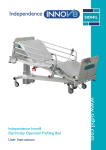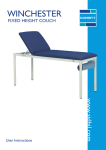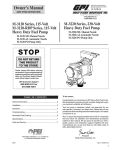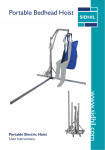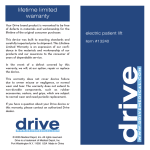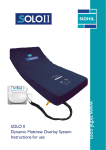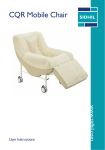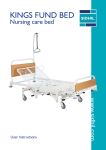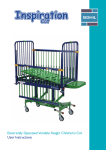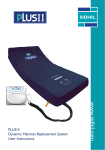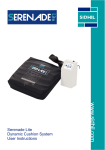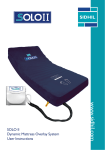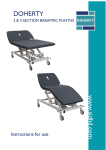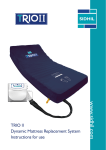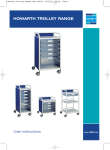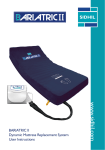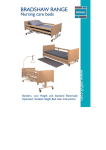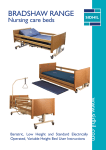Download w w w .sidhil.com
Transcript
Community Care Bed Range www.sidhil.com User Instructions CONTENTS 1. I NTRODUCTION 4 1.1 Features 4 1.2 Warnings & cautions 4 2. USE 5 2.1 Typical use 5 2.2 Risk assessment 5 2.3 Bed load 5 2.4 General warning 5 3. SYMBOL DEFINITION 6 4. PARTS IDENTIFICATION 7 5. BED ASSEMBLY AND PREPARING FOR USE 8 5.1 Removal from the transport stand 8 5.2 Assembling the bed 9 5.3 Fitting the electrical system 10 5.4 Stowing the transport stands 11 5.5 Checking the bed 11 6. OPERATION OF THE BED 12 6.1 General safety 12 6.2 Preparing for use 12 6.3 Brake system 13 6.4 Side rails 13 6.5 Mattress thickness 13 6.6 Electrical operation 14 6.6.1 Handset functions 14 6.6.2 Lockout function (SOLITE/UK/4 and SOLITE/UK/BB only) 15 6.7 Knee break / leg section 15 7. EXTENDING THE BED (all variants) 16 7.1 To extend the bed frame 16 7.2 To extend the platform 16 8. ASSEMBLY ONTO THE TRANSPORT STAND 17 8.1 Electrics 17 8.2 Bed frame 17 8.3 Assembling onto the stand 18 9. POWER FAILURES AND BATTERY BACKUP 19 10. LIFTING POLE (accessory) 20 11. DECONTAMINATION 21 12. MAINTENANCE 23 12.1 Fault finding 23 12.2 General maintenance 24 13. SPECIFICATION 25 13.1 Bed data 25 13.2 Electrical data 26 14. WARRANTY 27 3 1. INTRODUCTION Thank you for purchasing this product. The user manual should be read carefully before operating the bed. Please ensure that you understand all instructions, if you have any questions concerning the operation or maintenance of the bed please contact your provider/supplier who will provide you with expert professional advice. 1.1 Features • Electrically operated backrest, height and knee break angle (only 4 section offers full functionality). • Infinitely variable electrically operated head and foot down tilt (Trendelenburg & reverse Trendelenburg). • Auto-regressing backrest (not available on VH model). • Integral leg extension. • Auto contour – simultaneous adjustment of the backrest and knee break (not available on VH or 2 section models). • Patient handset with individual function lockout (only 4 section beds). • Bed breaks down into four separate sections. • Transport stand to aid storage and bed transportation. 1.2 Warnings and cautions Warnings in this user manual highlight potential hazards that if disregarded could lead to injury or death. Cautions in this user manual highlight potential hazards that if disregarded could lead to equipment damage or failure. 4 2. USE 2.1 Typical use Your bed is intended for use within the home environment. It has been designed to provide users with optimum independence and freedom of movement through the use of a touch button handset. The bed offers greatly reduced manual handling requirements for the carer by providing a bed, depending on the model selected, with a fully profiling platform and electrical height adjustment capability. 2.2 Risk assessment Before a patient uses the bed a risk assessment must be performed on a patient by patient basis. The risk assessment should include, but is not limited to: • Entrapment • Falling out of the bed • Small children (and adults) • Patients with learning difficulties • Unauthorised people Warning Bed functions must be locked out if there is any doubt about the ability of the patient to operate the bed safely. (Lockout functionality only on 4 section beds.) 2.3 Bed load The safe working load of the bed is: 222kg (35 stone) The maximum user weight of the bed is: 190kg (30 stone) 2.4 General warning Warning • Misused electrical equipment can be hazardous. • Accessories that have not been approved or designed for use with the bed should not be used. • Electrically operated beds should not be used in the presence of flammable gasses. 5 3. SYMBOL DEFINITION The following symbols are found on this bed: Warning Refer to user guide Maximum user weight & safe working load Place of manufacture W.E.E.E Label (Do not discard in general waste, follow local recycling policy.) Class II, Type B Refer to user guide for matress suitability 6 4. PARTS IDENTIFICATION 1 8 7 2 5 4 3 1. Head/foot end 2. Castor 3. Knee break actuator 4. Leg section 5. Locking collar 6. Hi/low actuator 7. Backrest actuator and control box 8. Backrest 9. Transport Stand 9 Note: Solite UK 4 section bed shown 7 6 5. BED ASSEMBLY AND PREPARING FOR USE Warning • Before attempting to assemble the bed ensure these instructions have been read and fully understood. • It is advisable to assemble the bed with a second able bodied person. • Take care when disassembling the bed from the transport stand, the sections are of considerable weight. 5.1 Removal from the transport stand No tools are necessary for the assembly of the bed. The assembly procedure is as follows: • Clear the area intended for the bed of any obstructions and ensure the surface is level. • Apply the brakes to the castors. • Remove the clevis pin, r-clip and plastic spacer that goes through each transport stand and holds the backrest in place (these parts will be required when assembling the bed sections together) and then lift this section off the stand and carefully place flat on the floor. • Loosen the hand wheels on the leg section (attaching it to the transport stand) and then lift this section off the stand and carefully place flat on the floor. • Turn the locking collars on one of the bed ends so that they are both in the unlocked position, this is easily identified by a visible warning triangle. • Carefully lift the ends of the transport stand away from the bed end and place carefully against a wall or on the floor. Note: when the transport stands are lifted away neither bed end will be supported. • Turn the locking collars on the remaining bed end so that they are in the unlocked position. • Carefully lift the ends of the transport stand away from this bed end. The bed has now been separated into its constituent parts. Collar locked 8 Collar unlocked 5. BED ASSEMBLY AND PREPARING FOR USE 5.2 Assembling the bed • Whilst supporting one of the bed ends against a wall, lift one of the mattress platform halves and hook into the bed end. Turn the locking collars into their locked position (warning triangle not visible). Note: If this action is being undertaken by a single person Sidhil recommend that the castors are braked before assembly commences. • Repeat for the remaining bed end and mattress platform half. • Release the brakes on the castors. • Bring both halves of the bed together and align each section so that the spigots in the backrest section locate into the open tube ends in the leg section. Pull the two sections together and tighten the 2 hand wheels. • Place the clevis pins through the tube with the head of the pin on the outside of the bed. Place plastic spacer over the end of the pin and insert the ‘R’ clips in from the top of the bed through the hole in the pin. Warning • The bed must never be used with the hand wheels loose or if missing. • The bed must never be used with the locking collars in the unlocked position or if missing. Caution If the bed has been supplied with tie wraps/Velcro (or similar) securing any of the sections in place ensure they are removed prior to operation. 9 5. BED ASSEMBLY AND PREPARING FOR USE 5.3 Fitting the electrical system • Plug the actuator and handset cables into the control box. The control box has a label showing the correct port into which the corresponding cable is inserted. Note, the plugs only fit into the ports in one orientation. Ensure the cables are plugged fully into the control box. Note: The two bed ends are identical however plugging them into the correct port is important. Note the location of the correct end before plugging in. • Once all the cables are connected they are to be secured in place by attaching the supplied anti-removal clip. • Clip the mains cable into the clip on the head end section of the bed (clip is secured by twisting ends together). • Drive bed to maximum height then secure actuator cables in the twist clips. Ensure each bed end actuator cable has enough flex to allow full movement of the actuator. Mains cable clip Backrest actuator Knee break acuator Foot end actuator Head end actuator Handset Note: The image shows a SOLITE/UK/4 control box label. Caution • Ensure all cables are free from moving parts and are not under excessive tension. • Ensure the two hi/low actuators are plugged into the correct ports, if the tilt function is not functioning as expected the cables may have been incorrectly located, double check against the diagram on the controlbox. 10 5. BED ASSEMBLY AND PREPARING FOR USE 5.4 Stowing the transport stands The bed comes complete with integral transport stand storage brackets. • Raise the bed to its full height . • Holding one transport stand turn it so the warning label is facing downwards. • Slide the stand into the tubes positioned under the bullet backrest section, push the spring clip down and push the stand past until the clip springs back locking the transport stand in position. • Repeat the procedure for the opposite side transport stand. Spring clip 5.5 Checking the bed The bed is now fully assembled. Before the bed is put into use ensure the bed is correctly assembled: • Are the locking collars on the corners of the bed correctly orientated in the locked position (no visible warning triangles)? • Are the 2 mattress platform and 4 extension hand-wheels tight? • Has all packaging been removed, e.g. cable ties/Velcro, securing the platform sections? • Are the cables free of all moving parts of the bed and is there sufficient slack in the cables to allow for movement? • Is the bed clear of obstructions? • Has a risk assessment been performed on the suitability of the bed for the user? • Have the 2 clevis pins been passed through the bed’s central join and secured with ‘R’ clips? 11 6. OPERATION OF THE BED 6.1 General Safety • When the bed is operated, ensure that obstacles such as over-bed tables and other furniture are not causing an obstruction. • Ensure the electrical cables are not in tension. • Ensure that any mattresses used are of the correct size and type and have been fitted correctly. A range of suitable pressure relieving and pressure reducing mattresses are available from Sidhil Ltd. • Before operating the bed ensure the patient is positioned appropriately. • When a patient is left unattended ensure the bed is set at its minimum height. Caution Special care should be taken when fitting an air mattress to the bed as incorrect fitting could damage the bed frame. 6.2 Preparing for use Prior to operating the bed for the first time the following simple checks must be performed: • Ensure the bed and all accessories are at room temperature. • Ensure the bed has been cleaned and disinfected (page 21). • Ensure the mains cable is plugged into an appropriate mains socket. • Ensure the brakes on the castors at the head end of the bed have been applied. • Using the handset ensure the bed is level (see page 14 for handset operation). Note: if the electrical functions do not operate ensure the handset has been ‘unlocked’ (see page 14 for handset operation) - not applicable to VH or 2 section beds. 12 6. OPERATION OF THE BED 6.3 Brake system The bed has 4 braked castors. • To apply the brakes: Press the brake pedal down. • To release the brakes: Lift the brake pedal up. When the bed is in use ensure the brakes on the castors at the head end of the bed have been applied. Warning • If the bed is to be pushed up/down a slope it is advised that two people move the bed, with one person at each end. • If the bed is to be pushed with a heavy load it should be assessed whether or not two people should move the bed, this is dependent on the situation and load on the bed. 6.4 Side rails The SOLITE UK bed range can be specified with four different types of side rail (Cantilever 3 & 4 side rails, Solite safe side and Savile trombone style side rails), this is to provide the optimum mattress/side rail combination for both foam and air mattresses of varying thicknesses. When specifying a mattress and side rail combination a clinical assessment of the patient’s needs must be carried out in line with the local policy. 6.5 Mattress thicknesses If an overlay air mattress is used it may be necessary to use a thinner foam mattress for the combined height to maintain the 270mm dimension. Refer to MHRA Device Bulletin DB2006 (06) ‘Safe use of bed rails’. Side rails pose a potential entrapment hazard, please refer to the side rail safety notice, SR/PSN 01/01/1, supplied with this product. Standard, 3 bar, cantilever side rail = 158mm maximum mattress thickness High, 4 bar, cantilever side rail = 270mm maximum mattress thickness Caution Do not use the side rails to move the bed. 13 6. OPERATION OF THE BED 6.6 Electrical operation The bed is supplied with an easy-to-use handset. The handset may be operated by the occupant or carer. If the carer is to operate the bed ensure that the occupant is made aware of the action(s) about to take place. Warning Ensure a risk assessment is undertaken to ensure the suitability of the occupant using the handset. 6.6.1 Handset functions 1. To raise the backrest depress button 1 until the desired angle is reached. (Solite 2 and 4 Section only.) 1 2 2. To lower the backrest depress button 2 until the desired angle is reached. (Solite 2 and 4 Section only.) 3 4 3. To raise the knee break depress button 3 until the desired angle is reached. (Solite 4 Section only.) 5 6 7 8 9 10 4. To lower the knee break depress button 4 until the desired angle is reached. (Solite 4 Section only.) 5. To raise the backrest and knee break (auto contour) depress button 5 until the desired angle is reached. (Solite 4 Section only.) 6. To lower the backrest and knee break depress button 6 until the desired angle is reached. (Solite 4 Section only.) 7. To raise the bed depress button 7 until the desired angle is reached. Note: SOLITE/UK/4 handset label shown 8. To lower the bed depress button 8 until the desired angle is reached. 9. To tilt the bed head end up depress button 9 until the desired height is reached. 10. To tilt the bed head end down depress button10 until the desired height is reached. 14 6. OPERATION OF THE BED 6.6.2 Lockout function (SOLITE/UK/4 and SOLITE/UK/4/BB only) The handset is supplied with a lockout function which enables the carer to disable any of the bed’s functions if they are deemed unsuitable for the occupant. To lock/unlock a function, turn the relevant function lock using the key provided (clockwise to lock, anti - clockwise to unlock). When a function has been locked a yellow dot will be visible above that function. Locked 6.7 Knee break/leg section Note: The operation of the knee break/leg section is dependent on the position of the support bow as detailed below. The bed is fitted with an adjustable leg section. When the knee break function on the handset is operated the height or angle of the leg section is adjusted, depending on whether or not the leg support is located in the channel on the underside of the leg section. Knee break height/angle adjustment: Leg section height adjustment: Leg section Support bow To set the bed so that the knee break is raised: • Press the knee break button on the handset and raise the leg section (height not important). • Lift the leg section a little so that the support bow releases from the channel and rests on the supporting tube. • Gently lower the leg section down. • The knee break angle will now become more acute as the knee is driven up. To set the bed so that the leg section is raised: • Press the knee break button on the handset and raise the knee break (height not important). • Lift the leg section a little so that the support bow located under the leg section can be lifted and located into the channel on the leg section. • The leg section will now raise parallel to the bed frame as the knee break is driven up. 15 7. EXTENDING THE BED (all variants) 7.1 To extend the bed frame • Flatten and lower the bed to its minimum height (see page 14 for operation of the handset). Bedframe hand wheels • Apply the brakes to the head end of the bed. • Unclip the foot end actuator cable from the bed frame cable clip (to prevent over extending the cable). • Loosen the four hand wheels at the foot end of the bed (2 per side). • Unlock the foot end castors whilst holding the foot end near the locking collars pull the bed extension out until it reaches the end stops. • Re-tighten all the hand wheels and secure the actuator cable back into its clip. 7.2 To extend the platform • Loosen by 3 - 4 turns the two hand wheels located on the platform section. Platform hand wheel • Slide the platform extension out to the correct length to suit the mattress and extension block being used (if a Sidhil mattress and extension are being used then it may be pulled out to the end stops). • Re-tighten the extension hand wheels (take care not to over tighten as damage to the extension tubes may occur). 7.3 Returning the bed to its original state is a reverse of the above. Warning The platform extension must be returned to its shortened length before reducing the main bed frame extension or severe damage could be caused to the platform extension. 16 8. ASSEMBLY ONTO THE TRANSPORT STAND Warning • Before attempting to assemble the bed onto the transport stand ensure these instructions have been read and fully understood. • It is advisable to assemble the bed with a second able bodied person. • Take care when assembling the bed onto the transport stand, the sections are of considerable weight. 8.1 Electrics • Flatten and lower the bed to its minimum height (see page 14 for operation of the handset). • Unplug the mains cable from the mains socket. • Using a flat bladed screwdriver remove the anti-removal clip from the control box. • Unplug the hi/low and knee break actuator cables from the control box (see page 10). 8.2 Bed frame • Release transport stands from their under bed storage brackets. • Release the brakes from the castors. • Loosen the hand wheels in the middle of the bed frame and remove the clevis pin, ‘R’ clip and spacer. • Whilst supporting both halves of the bed frame split the bed in half and gently lower onto the floor. • Unlock both locking collars on one end. • Whilst supporting the bed end lift the platform half away and gently position both sections on the floor/against a wall. • Repeat for the remaining half of the bed. • Using the 2 orange Velcro straps that first came with the bed, secure the moving parts of the backrest and leg section to the bed frame halves. (If applicable to your model.) 17 8. ASSEMBLY ONTO THE TRANSPORT STAND 8.3 Assembling onto the stand • Position both transport stand brackets onto one bed end, taking care to ensure the brackets are both orientated in the correct direction (each stand has a label showing correct side). • Turn both locking collars into the locked position. • Hook the remaining bed end onto the transport stands. • Turn both locking collars into the locked position. • Lock the castors. • Carefully lift the backrest section and lower the spigots through the larger open tubes on the side of the transport stand brackets, ensuring the electrics are facing inwards. • Carefully lift the leg section and lower the open end onto the vertical tubes, ensuring the electrics are facing inwards. • Tighten the hand wheels on the leg section frame. • Place the clevis pins through the backrest section and secure with the ‘R’ clips and spacers. • Ensure all cabling is neatly wrapped around the relevant bed sections and is not dragging on the floor or under excess tension. Warning The bed must never be moved on the transport stand with the locking collars in the unlocked position or missing. 18 9. POWER FAILURES AND BATTERY BACKUP The bed does not have battery backup functionality unless you have purchased the battery backup variant of the bed (SOLITE/UK/4/BB) this can be identified by a box fastened to the knee break motor. In the event of a power failure the bed will not function, resulting in the backrest and/or knee break remaining up, if previously raised. The backrest and knee break are operated via two individual actuators that are located underneath the mattress platform. • If either the backrest or knee break is raised, locate the actuator supporting the relevant section. • Hold/support the section. • Remove the pins that hold the actuator in place. • Gently lower the section(s) to the flattened position. Warning • It is recommend that 2 carers support the section prior to removing the pin. • When the pins are removed there is nothing supporting the section, the carer(s) holding the frame must be ready to support the weight on removal of the pin. Caution • If fitted with a Battery Backup this should only be used in an emergency for normal operation the bed must always be plugged into the mains supply. 19 10. LIFTING POLE (accessory) The patient lifting pole is supplied complete with strap and handle. Warning The maximum supporting weight of the pole is 80kg (12.5 stone) The lifting pole is inserted into one of the two sockets located in the corners of the backrest section of the bed. Ensure that the pin located in the lifting pole fits into the slot in the socket. Once inserted make sure that the lifting pole is stable and cannot rotate. Sidhil Ltd recommends frequent checking of an attached lifting pole. This should include looking for any signs of damage, loose stitching, fraying or any other material degradation. If evidence of any of the above is apparent, replace the strap and handle or the entire lifting pole assembly immediately. 20 11. DECONTAMINATION Infection control and routine cleaning must be carried out in accordance with your local Infection control policy or regulatory body. Your bed comes with an antibacterial additive incorporated into the powder coated metalwork. Biocote® inhibits the growth of bacteria on the surface of the bed frame. It is effective against a wide range of both gram positive and negative bacteria as well as fungi. Examples of bacteria that Biocote® is resistant to include: • Bacillus Subtilis • Staphylococcus Aureus (MRSA) • Escerichia Coli 0157 • Streptococcus Faecalis • Salmonella Enteritides • Listeria Monocytogenes Warning Biocote is an aid to keeping your bed infection free but it does not substitute the need for the bed to be cleaned at regular intervals. ® 21 11. DECONTAMINATION Warning Always disconnect the bed from the main power supply prior to cleaning. It is advisable to remove any accessories that are fastened to the bed. These instructions apply to all accessories apart from soft products (e.g. mattresses). • All surfaces to be wiped down with a disposable soft cloth moistened with a mild detergent and diluted in warm water (40°C). • The bed should be cleaned by starting with the cleanest parts of the bed and systematically moving to the dirtiest parts. Extra care should be taken around areas where excess dirt or dust may gather. • The cloth should be changed during the cleaning process if it becomes soiled. • Rinse down with clean water to remove detergent residue. • Wipe surfaces down with 1,000 parts per million chlorine solution (0.1%). • Dry off with a paper towel. • Always ensure the cleaned parts are allowed to dry before putting the mattress back in place. Note: If any of the 3 stages stated above (detergent, rinse down & chlorine solution) are omitted or combined it will reduce the effectiveness of the clean. In cases of blood spills or other bodily fluids it is recommended that a chlorine solution of 10,000 parts per million (1%) is used instead. Note: The use of neat bleach or similar surface cleaners are not recommended as damage may be caused to the cleaned surfaces. Alternatively: Sidhil recommend the use of Chlor-clean tablets. Follow the manufacturer’s instructions for concentration guidelines and instructions for use. Refer to the Sidhil infection control policy, copies are available from Sidhil Ltd. Contact details can be found on the back of this booklet. 22 12. MAINTENANCE Only authorised service personnel or Sidhil service engineers should carry out repairs or service activities. Failure to do so may result in the manufacturer’s warranty becoming void. The bed and its associated accessories must be serviced once yearly, as a minimum. Sidhil also recommends that the carer performs frequent visual and operational inspections. If there are any signs of damage or the bed is not performing as it should withdraw it from service until the bed has been repaired and is fit for use again. Periodically check to ensure that: • The bed operates as per its intended purpose. • All parts are present. • All fixtures and fittings are tight. • The frame is mechanically sound, with no cracking around welds. • No parts show signs of excessive wear. • The bed is cleaned following the guidelines in this user guide. Disposal of components must comply with local policy. 12.1 Fault finding Listed below are a set of electrical faults that may occur within the service life of the bed. If a fault does occur please try the following suggestions, as these may help in Fault Electrical function(s) do not work Electrical functions working slowly Possible Cause Remedy Functions locked out on handset (Not on Solite VH or 2 section beds) Unlock function(s) Mains lead not plugged into the control box or wall Check to see if the ‘power on’ light on the control box is lit and the mains lead is plugged in at both ends Fuse has blown in the mains plug Check to see if the ‘power on’ light on the control box is lit, if not replace fuse Actuator/handset leads not plugged in Check plug connections on the control box and actuators Damage to mains cable, actuator cable or handset cables Turn off at the mains and contact an approved service engineer Heavy load on the bed and the duty cycle has been exceeded If the control box has exceeded its duty cycle permanent damage will have occurred, a replacement control box will be required Heavy load on the bed Remove load Bed is operating on battery power (Solite Battery Backup only) Check mains cable is plugged in at both ends and turned on 23 12. MAINTENANCE 12.2 General maintenance Sidhil recommend that the following maintenance procedure is performed every 12 months. Warning Always disconnect the bed from the main power supply and battery backup prior to performing any maintenance procedures. • Check that all electrical functions operate correctly on the handset. • Check that all electrical cables are in good condition. • Check that the mains cable and plug are in good condition, if either is damaged it must be replaced as a complete assembly, the plug must never be re-wired. • Check that all nuts, bolts and fasteners are tight and that none are missing or incomplete. • Check that all locking collars and hand wheels are present. • Check that both the knee break and leg rest functions work correctly. • Check the castors lock/unlock correctly and that when locked the castors do not swivel or roll. • Check that the frame is mechanically sound with no cracking at welds etc. • Check the extension capability. • Check backrest sliders for wear/degredation. For more detailed service information please contact Sidhil Ltd. 24 13. SPECIFICATION 13.1 Bed data Overall length 2250mm - 2395mm Overall width 970mm Mattress platform height 300mm – 705mm Under bed clearance (to underside of frame) 250mm Under bed clearance (to underside of actuator) 105mm Mattress platform length 2000mm - 2145mm Mattress platform width 927mm (suits 880mm mattress) Head down tilt 0 - 11° Foot down tilt 0 - 11° Mattress platform angles of 4 section bed 70° 13° Backrest regression 100mm Safe working load 222kg (35 stone) Maximum user weight 191kg (30 stone) Product weight: (On transport stand): Individual Item weight Backrest Backrest (non profiling) Leg Section (with knee break) Leg Section (non profiling) Bed End 25 75kg 19.5kg 12kg 19kg 11kg 17kg 24° 13. SPECIFICATION 13.2 Electrical data Voltage in 240V, ~50/60Hz Current in Max. 1A Duty rating 10% Max 2/18min. Safety standards BS EN 60601-1: 2006 BS EN 60601-2-52:2010 EMC BS EN 60601-1-2:2002 Electrical shock protection Liquid ingress protection IP54 The electrical system is only suitable for use when: Ambient temperature +5° to +40°C Humidity 20% - 90% at 30°C 26 14. WARRANTY Sidhil Ltd guarantees this product is free from defects in material and workmanship under normal use for 5 years (1 year full for parts and labour, 4 further years for parts only) from the date of purchase from Sidhil Ltd and its subsidiary companies or its authorised dealers. All implied warranties, including but not limited to those implied warranties of fitness and merchantability, are limited in the total duration of one year from date of purchase. Proof of purchase must be presented with any claim. Except as provided herein, Sidhil Ltd, product warranty does not cover damage caused by misuse or abuse, accident, the attachment of any unauthorised accessory, alteration to the product, or any other conditions whatsoever that are beyond the control of Sidhil Ltd. Sidhil Ltd and its subsidiary companies shall have no liability or responsibility to customer or any other person or entity with respect to any liability, loss or damage caused direct or indirectly by use or performance of the product or arising out of any breach of this warranty, including but not limited to any damages resulting from inconvenience, loss of time, property, revenue, or profit or any indirect, special, incidental or consequential damages, even if Sidhil Ltd or their subsidiary companies or authorised dealers has been advised of the possibility of such damages. In the event of a product defect during the warranty period you should contact Sidhil Ltd or their authorised dealer who will at its option unless otherwise provided by law; a) correct the defect by product repair without charge for parts and labour b) replace the product with one of the same or similar design or c) refund the purchase price. All replaced parts and products on which refund is made become the property of Sidhil Ltd. New or reconditioned parts and products may be used in the performance of warranty service. Repaired or replaced parts and products are warranted for the remainder of the original warranty period. You will be charged for repair or replacement of the product made after the expiration of the warranty period. This warranty does not cover; a) damage or failure by or attributes to acts of God, abuse, accident, misuse, improper or abnormal usage, failure to follow instructions, improper installation or maintenance, alterations, lightning or other incidence of excess voltage or current, b) any repairs other than those provided by a Sidhil Ltd authorised technician, c) consumables such as fuses, d) cosmetic damage, e) transportation, shipping or insurance costs or f) costs of product removal, installation setup service adjustment or re-installation. This limited 5 year warranty gives you specific legal rights and you may also have other rights. Sidhil Ltd cannot be held responsible for any injury or incident which relates to the use of this bed in conjunction with accessories manufactured by companies other than Sidhil Ltd. All products carry the CE mark in accordance with EC Directive on Medical Devices (93/42/EEC). Sidhil has a policy of continual product improvement and reserves the right to amend specifications covered in this brochure. No part of this brochure may be reproduced without the written approval of Sidhil Ltd. 27 CONTACT INFORMATION Tel: 01422 233000 Fax: 01422 233010 Email: [email protected] www.sidhil.com Sidhil Business Park, Holmfield, Halifax, HX2 9TN A member of the Siddall & Hilton Ltd. Group of Companies (93/42/EEC) Certificate No. FM14550 INSTRUC/SOLITE/UK, 9/11/11 - rev1





























